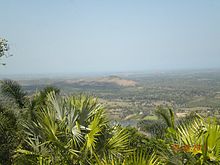| This article is written like a personal reflection, personal essay, or argumentative essay that states a Misplaced Pages editor's personal feelings or presents an original argument about a topic. Please help improve it by rewriting it in an encyclopedic style. (June 2011) (Learn how and when to remove this message) |
Cuba possesses a diverse range of natural habitats, housing a wide variety of species, including many endangered ones. However, the country has faced environmental challenges, particularly deforestation, since the arrival of European settlers. Forest areas have been cleared for agricultural purposes, leading to the loss of forests and the extinction of certain species. The cutting down of trees for fuel and construction materials has further contributed to this issue.
Environmental awareness has grown in Cuba over the years. In the late 1990s and 2000s, the Cuban government initiated new programs aimed at protecting the environment and increasing forest coverage. These efforts demonstrate a commitment to preserving the natural heritage of Cuba and safeguarding its biodiversity.
Environmental issues

Soil and desertification are the main causes of environmental problems. In addition, Cuba has other issues such as deforestation, water pollution, the loss of biodiversity, and air pollution. Soil degradation and desertification are produced by the lack of good farming techniques and natural disasters. Deforestation is killing the forest, for example, by cutting down trees. Water pollution is the contamination of water caused by different industries. Also, the loss of biological diversity is caused by the extinction of different animal species. Lastly, air pollution is largely caused by the increasing number of "old" cars that fill Cuba's streets.

Cuba had a 2018 Forest Landscape Integrity Index mean score of 5.4/10, ranking it 102nd globally out of 172 countries.
Marine biodiversity
Cuba is renowned for its extensive coral reefs, spanning over 1,000 square miles, and hosting more than one-third of all coral reefs in the Caribbean basin. This makes it home to the region's largest mangrove forest. The Nature Conservancy has been active in Cuba for over 20 years, focusing on improving marine management and implementing ecosystem-based adaptations to climate change. Their work, alongside local government cooperation, aims to preserve Cuba's iconic reefs and rich biodiversity.
Environmental solutions
One of the main solutions used by Cuba to regulate the environmental problem was creating an Environmental Educational program. This helped with the environmental problems by educating Cuban people about observing the environment. For example, the community contributed to neighborhood clean-up techniques. The government created new methods to prevent the destruction of the environment, such as organic farming versus using chemicals to treat the lands. Designated areas were built for garbage and industrial waste instead of dumping them into Havana Bay.
Cuba's approach to addressing environmental challenges includes significant international cooperation. For example, the Sister Sanctuaries Agreement between the U.S. National Oceanic and Atmospheric Administration, the National Park Service, and Cuba's Ministry of Science, Technology, and Environment focuses on stewardship and scientific research in Marine Protected Areas.
Despite challenges in accessing international funds due to political and economic constraints, Cuba has pursued innovative solutions to finance its conservation efforts. Initiatives include the National Fund for Forest Development (FONADEF) and the proposed National Fund for Protected Areas (FONAP), which aim to ensure the financial sustainability of conservation projects. In addition, partnerships with international donors and the exploration of payments for ecosystem services (PES) are part of Cuba's strategy to secure necessary funding for its biodiversity conservation efforts.
In 1994, CubaSolar was established during this energy crisis to bring together engineers, scientists, and planners to develop alternative energy capacity. It seeks to promote solar energy, biogas, hydropower, and solar thermal energy. CubaSolar has participated in projects to mitigate desertification. It has built greenhouses for research on seed cultivation.
References
- United Nations Environment Program. Conference on Water, Report of Cuba. Volunteer Hydraulic. 2001; 13(39): 47–59.
- Grantham, H. S.; Duncan, A.; Evans, T. D.; Jones, K. R.; Beyer, H. L.; Schuster, R.; Walston, J.; Ray, J. C.; Robinson, J. G.; Callow, M.; Clements, T.; Costa, H. M.; DeGemmis, A.; Elsen, P. R.; Ervin, J.; Franco, P.; Goldman, E.; Goetz, S.; Hansen, A.; Hofsvang, E.; Jantz, P.; Jupiter, S.; Kang, A.; Langhammer, P.; Laurance, W. F.; Lieberman, S.; Linkie, M.; Malhi, Y.; Maxwell, S.; Mendez, M.; Mittermeier, R.; Murray, N. J.; Possingham, H.; Radachowsky, J.; Saatchi, S.; Samper, C.; Silverman, J.; Shapiro, A.; Strassburg, B.; Stevens, T.; Stokes, E.; Taylor, R.; Tear, T.; Tizard, R.; Venter, O.; Visconti, P.; Wang, S.; Watson, J. E. M. (2020). "Anthropogenic modification of forests means only 40% of remaining forests have high ecosystem integrity - Supplementary Material". Nature Communications. 11 (1). doi:10.1038/s41467-020-19493-3. ISSN 2041-1723. PMC 7723057.
- "The Nature Conservancy in Cuba". The Nature Conservancy. Retrieved 2024-03-14.
- Skanavis, C.; Sarri, E. (2004). "Need for sustainable development awareness management in Cuba". International Journal of Sustainable Development & World Ecology. 11 (4): 356. doi:10.1080/13504500409469839.
- ^ "Cuba's Biodiversity Offers Hope for Caribbean Ecosystem Conservation | Conservation Finance Network". www.conservationfinancenetwork.org. 2016-07-12. Retrieved 2024-03-14.
- ^ Yaffe, Helen (2020). We Are Cuba!: How a Revolutionary People Have Survived in a Post-Soviet World. Yale University Press. ISBN 978-0-300-24551-6.
- Cederlöf, Gustav (2023). The Low-Carbon Contradiction: Energy Transition, Geopolitics, and the Infrastructural State in Cuba. Critical environments: nature, science, and politics. Oakland, California: University of California Press. ISBN 978-0-520-39313-4.